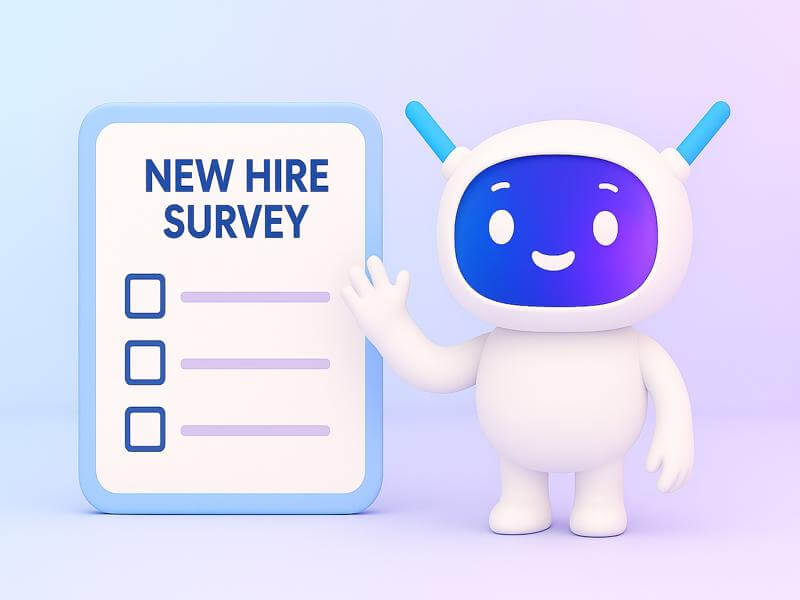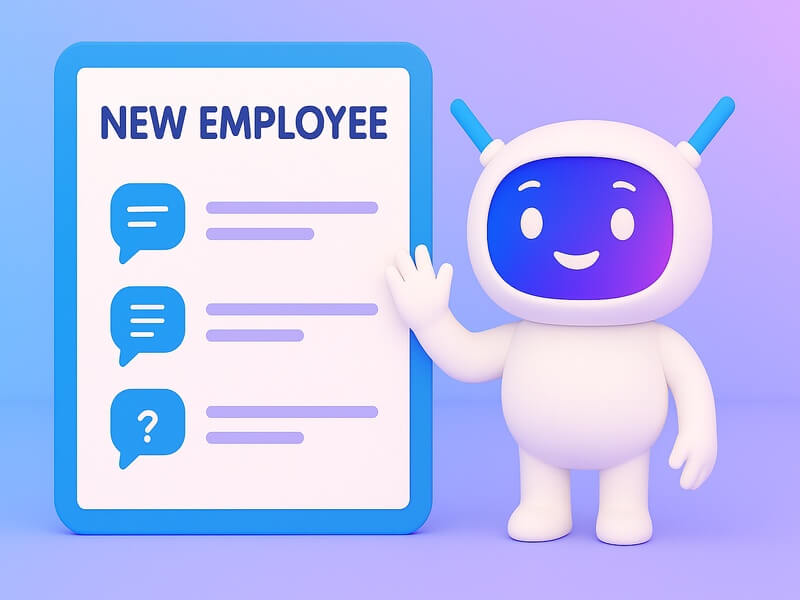.jpg)
What is survey feedback?
There are two ways to approach human resource problems. One involves conjecture, intuition, and lucky guesses. The other is based on research, data, and inductive reasoning.
If you're into luck and conjecture, survey feedback may not be worth your trouble. But if you're in the research camp, survey feedback is the source of all your data and the goldmine behind all that information which powers your decisions.
Survey feedback is, as the name suggests, feedback acquired by means of a survey. It could be about anything that human beings can be surveyed on, including employee experience, job satisfaction, digital customer care, or workplace culture.
Benefits of survey feedback
Survey feedback allows the survey provider to gain insight into the thoughts and opinions of a large group of people. Benefits of survey use in the workplace include:
- Provide actionable feedback that can be translated into measurable improvements
- Enable respondents to feel heard, leading to higher satisfaction and engagement.
- When an open-ended question is included honest feedback may include unexpected user feedback may provide a much more complete view of the situation than was available before.
Whether or not a given survey meets its potential will depend on the survey itself, question wording, percentage of open-ended/scale questions, etc. -- as well as on the survey implementation. A well-worded survey with good implementation is almost unlimited in the amount of information it can elucidate.
If you're having trouble with survey feedback, if the survey isn't yielding any results, is taking too long, or isn't relevant to your business needs, check these three components:
- Bias: Do the questions contain leading phrases, or is there an obvious 'right answer for any question.
- Timing: does the survey represent a reasonable time frame from the survey subject's perspective?
- Relevancy: is this survey truly relevant to your business needs? Are you asking questions that need to be answered? Are you avoiding questions that don't need an answer?
For survey feedback to truly be survey feedback, it needs survey respondents. That's where survey invitation management software comes into play. Simply put, survey invitation management software will do everything in its power to make sure that you get the survey responses you need, because your business depends on it!
Although there are many ways for companies to gather employee feedback, survey feedback is a step above the rest. It's a survey tool that companies across all industries and positions can rely on, from tech start-ups to large corporations. With survey invitation management software boosting your survey results, you're one step closer to answering important questions about the opinions of your employees.
The most commonly used feedback surveys include:
- Manager feedback surveys
- Employee feedback surveys
- Staff feedback surveys
- Customer feedback surveys
We'll look at each of these in detail, and then we'll look at best practices that will enable you to collect the most insightful survey feedback.
Manager feedback surveys
When you're deciding how to handle things like customer satisfaction, client relations, or other aspects of human capital management where survey feedback can help, it's natural to turn first to managers. Managers are the frontline workers who interact with survey participants on a daily basis.
As such, they should be familiar with the expectations and concerns of everyone in their teams. In an ideal world, they should have an impartial view of all subordinates, their interactions with customers/clients, etc.
Manager feedback surveys can be conducted either 1:1 or in groups. For example, managers could be sent a survey by email, put on conference calls, or asked to come in for a survey feedback session.
It's important to survey managers on a regular basis, for two reasons. First, survey feedback will vary from one survey to the next, so survey takers need to have updates in order to track changes and analyze trends. Second, survey feedback is highly dependent on transient factors such as the weather or seasonality. During the dark winter months survey respondents tend to be more dissatisfied and pessimistic than in the summer when it's warmer and people feel more relaxed.
Manager surveys are easy to implement because you are working with people who are used to filling out reports and questionnaires, and the number of individuals being surveyed is typically not large. The downside of using this type of survey to determine employee experience is that you are relying on a third-person report rather than going directly to the source.
Employee feedback surveys
In many industries survey feedback is solicited from employees themselves. The survey participants get an email inviting them to participate and providing a link to the survey. Employee survey feedback allows managers and leaders to get a sense of what their teams are thinking about certain topics.
Employee survey feedback is typically anonymized and survey takers receive a survey link by email. The survey may focus on asking employees about their satisfaction with certain aspects of work-life or culture at their organization as a whole. Often, a survey question will ask the respondent to rate an experience or opinion on the likert scale.
The survey itself is usually created by the survey provider, but employers will sometimes use survey software to do an in-house survey. These survey participants are often asked open-ended questions to better allow them to provide a more detailed response about their work.
Employee feedback surveys typically provide the most useful information for human capital management, because the survey participant is the person in charge of completing the survey and he or she is often more motivated to complete it than managers. An employee will also have a more accurate view of his or her own experience and satisfaction than does a manager making assumptions about subordinates.
An employee engagement survey is used primarily to gain a benchmark on employee engagement across teams, although if the questionnaire includes open-ended questions it may also be used to elucidate problem areas that should be targeted by HR. Employee satisfaction surveys, in a similar manner, can be used to determine the employee satisfaction benchmark so that trends can be plotted over time.
Employees will be able to focus much more on their own personal work experience because survey feedback survey participants are not asked to provide any information about other employees. Employee feedback surveys also allow survey participants to voice any grievances they may have about their work environment.
Staff feedback surveys
As the name suggests, staff feedback surveys are sent out to specific members of staff or teams within an organization. They are given a survey link which is typically only used by survey takers within that particular area.
Staff survey feedback surveys are useful for organizations who want to take a more targeted approach to survey feedback, because the survey participants are either related or familiar with each other already. This type of survey allows survey takers to discuss their areas' specific work environment and challenges in an interactive survey feedback session, instead of survey takers having to answer survey feedback survey questions on their own with respect to the entire organization.
Customer survey feedback
Customer feedback surveys are often used to better understand the customer experience and guide changes to customer service. For instance, a customer satisfaction survey has the potential to give actionable insights that lead to higher customer retention, and a post purchase survey opens a window on the customer service surrounding a given purchase, allowing the retailer to see where improvements could be made.
An NPS survey is a type of customer survey that uses the market research metric net promoter score, NPS, to rate customer loyalty. In this survey, respondents will be asked how likely they are to recommend your business to a friend or colleague. For businesses evaluating their approach to customer engagement, it can offer valuable insight alongside insights gained from exploring top loyalty platforms, such as those featured in comprehensive lists like the top-12 best loyalty-program software solutions around the world.
Customer satisfaction survey questions may include specific questions on the service experience, as well as feelings and thoughts the customer has about the organization itself. This type of customer survey can lead to higher customer loyalty even before suggested changes are made, as the simple act of engaging with your organization through a survey enables the customer to feel valued and enhances the customer journey. If you really want happy customers, though, you will want to listen to their suggestions.
Best practices for survey feedback
There are certain best practices that can be used when sending out any type of feedback surveys. First, it's important that before you send out a survey link, survey takers have had some sort of training on how to fill it out. This training should include some guidelines that will allow survey-takers to be more successful when filling out survey feedback surveys. The survey process itself should also be tested so you can find out what survey respondents are finding easy or difficult about the survey.
If you're in charge of writing surveys, keep these things in mind:
- Draft open-ended questions with the least possible bias.
- Include a sufficient number of scale questions to ensure statistical significance.
- Make survey feedback survey questions relevant to all survey takers.
- Try not to include more than 10 survey questions per survey.
Survey feedback software
In the end, survey feedback boils down to three components: good survey questions, a large enough sample size, and reliable survey software. To ensure that you make the most out of your survey results, no matter what industry your business is in or what type of survey you're creating, quality survey software is a must-have. A survey platform can help ensure survey results are clean, accurate and precise by providing the following features:
- A survey creation tool
- Edit pre-existing survey templates
- Customize question wording using survey logic trees
- Track survey progress and performance
- Export data from open-ended survey questions
- Conduct survey research
- Analyze survey data in a variety of charts and graphs
- Share survey feedback survey results with survey takers
- Allow survey takers to provide comments about survey questions
Many of the people who receive an employee survey may not know how to express their opinions. This makes the process of creating a survey seem daunting to many employees, and prevents them from taking surveys at all. Many companies make survey feedback survey participation mandatory, which can lead to uninspired survey responses. Employees who feel that their opinions don't matter will not take the survey seriously and may give off-the-cuff answers instead of giving accurate accounts of what is going on in their workplace.
Sometimes, the solution to this problem is to first work on creating a culture of feedback in which employees are comfortable sharing their opinions in an honest, constructive manner. One of the best software options for this is the free Slack app Matter, which allows team members to both request and give feedback.
Done right, an employee or manager survey can be one of the most useful methods for gathering information there is. Survey feedback has the potential to inform employee development decisions, company policy, and workplace culture initiatives. Don't rush out a poorly worded, biased survey: instead, take the time to get survey feedback survey questions right, choose the best survey tool, and work on creating a feedback culture. The investment will be worth it!
























